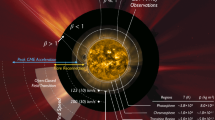Abstract
The Kitt Peak multi-channel magnetograph was used to make raster scans of the super-granulation. The region scanned was carefully selected to be quiet and was located at the center of the disk. Each point in the raster was observed twice (with a time interval of 150 sec) and averaged, thereby cancelling out effects of the 5 min oscillations. Subsequent raster scans were made over a period of 4 h and averaged, further reducing short-lived, nonperiodic modes and enhancing the long-lived super-granulation.
The results clearly show vertical supergranular motions. These motions consist of relatively isolated ‘patches’ of downward flowing material, or ‘downdrafts’, with a speed of approximately 0.1 km/sec. These downdrafts are highly correlated with patches of magnetic field, being not only cospatial with them but also approximately linearly proportional to the field strength. The magnetic field strength of these downdrafts is in the range from 50 to 100 G. These downdrafts are also regions of increased temperature (i.e., brighter than average) at all levels observed, from the Caii K line down to the level of the continuum.
The observations show no contradiction with the hypothesis that the supergranulation is a convective phenomenon, but they do indicate that the convection would be far more complicated than previously supposed. In particular, the surprisingly large field strengths and the presence of a bright network at all levels suggest that the magnetic field plays a far more active role in the supergranulation.
Similar content being viewed by others
References
Beckers, J. M.: 1968, Solar Phys. 5, 309.
Frazier, E. N. and Scherrer, P. H.: 1969, Solar Phys. 10, 297, Paper I.
Harvey, J. and Livingston, W. C.: 1969, Solar Phys. 10, 283.
Leighton, R. B.: 1964, Astrophys. J. 140, 1547.
Leighton, R. B.: 1969, Astrophys. J. 156, 1.
Leighton, R. B., Noyes, R. W., and Simon, G. W.: 1962, Astrophys. J. 135, 474.
Livingston, W. C.: 1968, Astrophys. J. 153, 929.
Livingston, W. C. and Harvey, J.: 1969, Solar Phys. 10, 294.
Parker, E. N.: 1963, Astrophys. J. 138, 552.
Pellew, A. and Southwell, R. V.: 1940, Proc. Roy. Soc. London, A. 176, 312.
Piddington, J. H.: 1956, Monthly Notices Roy. Astron. Soc. 116, 314.
Rogers, E. H.: 1970, Solar Phys. 13, 57.
Simon, G. W. and Leighton, R. B.: 1964, Astrophys. J. 140, 1120.
Tanenbaum, A. S., Wilcox, J. M., Frazier, E. N., and Howard, R.: 1969, Solar Phys. 9, 328.
Author information
Authors and Affiliations
Additional information
Visiting Astronomer, Kitt Peak National Observatory, which is operated by the Association of Universities for Research in Astronomy, Inc., under contract with the National Science Foundation.
Rights and permissions
About this article
Cite this article
Frazier, E.N. Multi-channel magnetograph observations. Sol Phys 14, 89–111 (1970). https://doi.org/10.1007/BF00240163
Received:
Issue Date:
DOI: https://doi.org/10.1007/BF00240163




